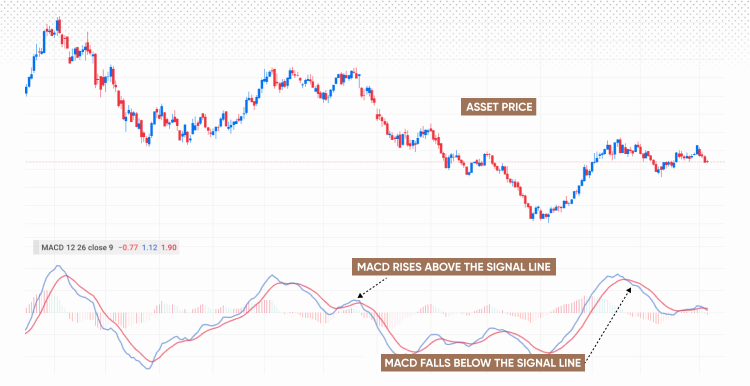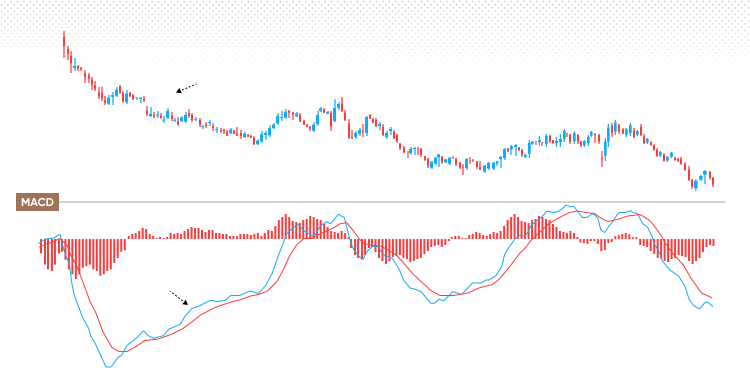How does MACD work?
The MACD is derived from subtracting the 26-day exponential moving average (EMA) from the 12-day EMA. The signal line, which is the nine-day EMA of the MACD, is then drawn. The signal line could be used as a threshold to help define buying and selling points.
The EMA differs from a standard moving average in that greater weight is placed on the more recent data. In this way, the EMA responds more quickly to price changes versus a simple moving average. It differs from the regular weighted moving average (WMA) in that whereas the weight in the WMA increases on a regular basis, in the EMA it does so exponentially.
The MACD formula
If we want to express how to get the MACD as a formula, this is it
MACD =12-Period EMA − 26-Period EMA
How to read the Moving Average Convergence Divergence indicator?
Traders may consider using the MACD in the following ways:
Identifying momentum: Looking for places where the two moving averages crossover can suggest a change of momentum.
Finding a trend’s strength: The size of the histogram’s bars can show traders how fast a price is moving, and what direction it is moving in.
Trend reversals: A divergence, where the price chart is going one way and the MACD is going another, can suggest that a reversal might be about to take place, although this is by no means guaranteed
Since it is derived from the actual price changes of the moving averages rather than the percentage changes, the MACD is categorised as an Absolute Price Oscillator (APO) as opposed to a Percentage Price Oscillator (PPO).
How to use the MACD indicator
Traders could use MACD signals to identify potential buy and sell scenarios in the market. The MACD generates signals through crossovers between the MACD line and the signal line, as well as through divergences between the MACD line and the price of the asset being analysed. Here are some ways to identify buy and sell signals using the MACD:
Bullish signal: A bullish signal occurs when the MACD line crosses above the signal line. This may indicate that the asset’s price is likely to increase in the near term, and traders may consider buying the asset.
Bearish signal: A bearish signal occurs when the MACD line crosses below the signal line. This may indicate that the asset’s price is likely to decrease in the near term, and traders may consider selling the asset.
Divergence signal: A divergence signal occurs when the MACD line diverges from the price of the asset. A bullish divergence occurs when the MACD line is making higher lows while the asset’s price is making lower lows, indicating that a reversal in price may occur. A bearish divergence occurs when the MACD line is making lower highs while the asset’s price is making higher highs, indicating that a potential trend reversal may occur.
Indicators that work with MACD
There are several technical indicators that traders could use in conjunction with MACD to confirm trend changes and generate trading signals. Some of these indicators include:
Relative Strength Index (RSI): RSI measures the strength of the asset’s price movement and can confirm overbought or oversold conditions in the market.
Moving Averages: Moving averages smooth out the asset’s price movement and can assist traders identify support and resistance levels.
Bollinger Bands: Bollinger Bands can be used to identify potential breakouts and reversals.
Fibonacci retracements: Fibonacci retracements can determine potential support and resistance levels.
Traders could use these indicators in combination with the MACD indicator to increase the probability of accurate trading signals. However, it is important to note that no single indicator can provide a complete picture of the market, and traders may consider using multiple indicators and analysis to make informed decisions.
Timeframe selection
Selecting an appropriate timeframe could be useful when it comes to formulating a MACD trading strategy. Shorter timeframes, such as 5-minute or 15-minute charts, can generate more frequent signals, but may also produce more false signals due to market noise. Longer timeframes, such as daily or weekly charts, can provide more clear signals, but may have fewer chances to trade.
Traders may consider their trading goals, risk tolerance, and preferred trading style when selecting a timeframe. It might be useful to monitor multiple timeframes to gain a complete picture of the market, and to adjust the timeframe as necessary based on changing market conditions.
Stop-loss and take-profit
Traders who use a MACD indicator strategy could also use stop-loss and take-profit orders. Stop-loss orders allow people to set a level of loss that they are prepared to suffer, while take-profit orders let them set a level of profit they are happy to take.
It is important to note that, unless a trader utilises guaranteed stop-loss, which comes at a fee, it may not protect them from slippage in the events of extreme market volatility.
Testing the MACD
Backtesting and forward testing can be useful for evaluating the effectiveness and reliability of MACD strategies. Backtesting involves applying the strategy to historical market data to assess its performance, while forward testing involves applying the strategy to real-time market data to validate its efficacy. Both methods can help traders identify potential flaws and optimise the strategy for a potential better performance.
MACD trading examples
Let’s take a look at some examples of trading with the Moving Average Convergence/Divergence indicator.
Trading MACD crossovers
When the MACD rises above the signal line, traders view this as bullish and may choose to go long on the asset in anticipation of upward momentum.
In contrast, the MACD falling below the signal line is a bearish prompt that traders may act upon to take short positions in the asset as they seek to profit from price falls.











